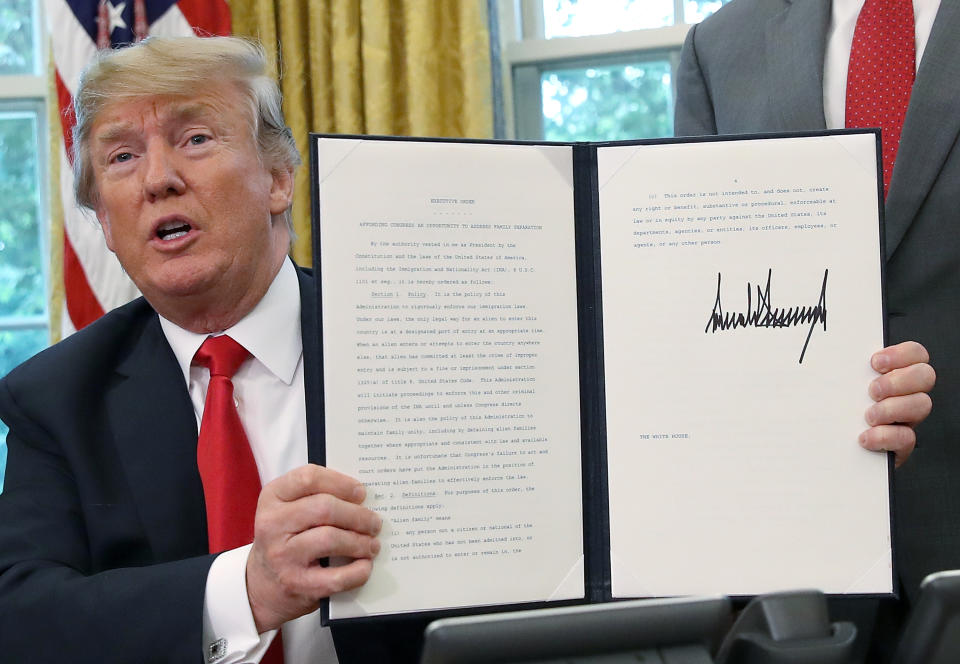Trump signs order to 'address' separations, but it won't change the situation for children in shelters now
WASHINGTON — After widespread outrage over his policy of separating children from their parents who crossed the border illegally, President Trump signed an executive order on Wednesday to “address family separations.” The order directs the Department of Homeland Security to “maintain custody of alien families” to the “extent permitted by law” when resources are available.
Democrats and a growing number of Republicans had called on Trump to issue such an order, but for weeks he had insisted that the policy was required by law and could only be changed by Congress. He blamed Democrats, who are in the minority in both houses, for not acting on the matter.
However, the order won’t make a difference for thousands of children who have already been taken from their families.
The spate of child separations resulted from a “zero tolerance” policy that was announced by Attorney General Jeff Sessions in April and enacted the following month. Last week, officials announced that between April 19 and May 31 about 1,995 children were separated at the U.S. border from adults they had traveled with. By treating all illegal border crossings as crimes — a break with previous administrations — the policy meant that adults would be sent to jail and that the children who entered with them would be separated them from. While Trump suggested his order would end separations going forward, an official confirmed to Yahoo News that the children already in custody would not be immediately reunited with their families.
Kenneth Wolfe, a spokesperson for the Department of Health and Human Service’s Administration for Children and Families (ACF), said the “process will proceed as usual” for the minors currently in the agency’s program. The department operates 100 shelters for migrant children in 17 states. Wolfe did not respond to a request for comment about how many children are currently in custody who have been separated from their parents.
Trump’s order states that it is “the policy of this Administration to maintain family unity, including by detaining alien families together where appropriate and consistent with law and available resources.” Agencies are instructed to keep families intact during legal proceedings when children enter the U.S. accompanied by someone with whom they have a “legal parent-child relationship.” Officials are given some discretion in implementing the order, subject to the availability of resources such as suitable housing and to a determination that keeping the family together would not “pose a risk to the child’s welfare.”
The order also calls for cases involving families to be fast tracked so they can avoid lengthy detentions. It also directs the Department of Defense and other agencies to identify additional resources the government can use to house families together. In the months leading up to the announcement of the child separation facility, the government awarded hundreds of millions of dollars in contracts to companies to build and operate shelters where immigrant children could be held. Those shelters may need to be modified to hold adults.

Amid the outcry over the policy, which was fueled by pictures and recordings of toddlers crying for their parents, and parents who couldn’t find out what happened to their children, Trump and other top officials made a series of conflicting and untrue statements about the separations.
Trump repeatedly falsely blamed the situation on Democrats even though they have never pushed for a policy that would call for family separations. The administration also denied the policy was intended to deter potential illegal immigrants with the prospect of family separations, even though White House chief of staff John Kelly explicitly said he was “considering exactly that” in a 2017 television interview when he was homeland security secretary. The administration also blamed the policy on the failure of Congress to make a deal on immigration reform. And the White House also suggested a 1997 federal court decision known as the Flores agreement that requires the government to release immigrant children to families “without unnecessary delay” and to keep them in the “least restrictive conditions” possible prevented the administration from keeping families in custody together.
The executive order Trump signed on Wednesday belies his claims that he was powerless to reverse the policy. Nevertheless, the order referenced the administration’s frustration with Congress’ inability to make an immigration deal. It framed the measure as “affording Congress an opportunity to address family separation” on a permanent basis. The order also directs Attorney General Jeff Sessions to “promptly file a request with the U.S. District Court for the Central District of California” to modify the Flores agreement to allow the secretary of homeland security to “detain families together” during their legal proceedings “under present resource constraints.”
As he signed the order in the Oval Office, Trump said he disliked the family separations and suggested they would end.
“I consider it to be a very important executive order. It’s about keeping families together while at the same time being sure that we have a very powerful, very strong border,” Trump said, adding, “So we’re going to have strong, very strong borders, but we’re going to keep the families together. I didn’t like the sight or the feeling of families being separated.”
Update [6:31 p.m.]: This piece was updated with the HHS spokesperson’s comment about the children currently in custody.
_____
Read more from Yahoo News:


